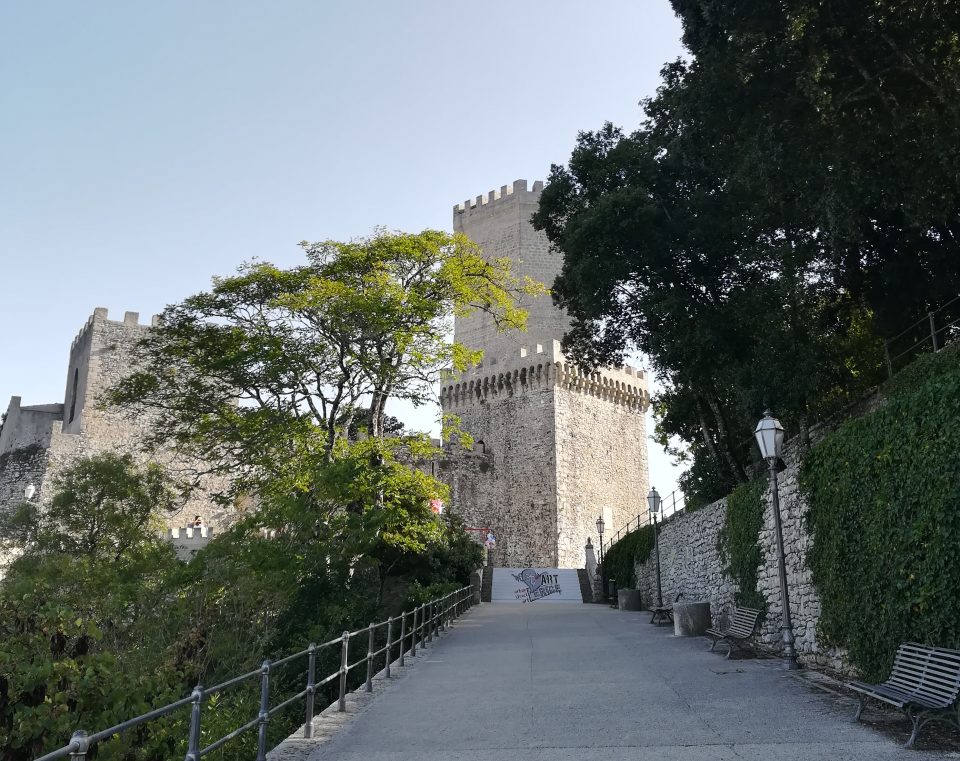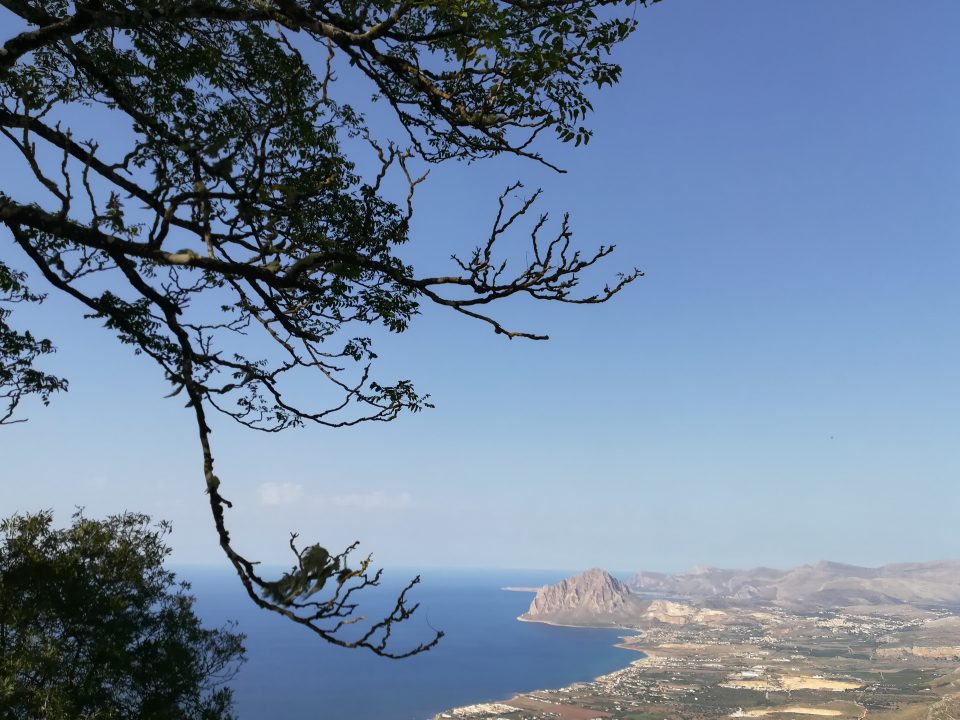The building of the Norman Castle
The building of the Norman castle. After the darkness of Arab period, Erice flourished again in the XII century thanks to the Altavilla, one of the most important families of Norman origin. They were successful in snatching Sicily from Muslim rule. The Altavilla were indeed the main allies of the Pope. They conquered the town of Erice bringing it back to its ancient splendor.
The Norman Castle or Venus Castle
Normans rebuilt the old fortress on the crumbling structure of the temple of Venus, on the same cylindrical rock.
It became the strongholds of the island within the defence plan prearranged by the Normans.
A drawbridge connected the rock to the surrounding plain on which still stands the advanced towers of the fortress. Later a viaduct with many steps replaced the drawbridge. Two embattled curtains link three towers.
Some curtains close the fortress walls, dividing them into two parts that integrate each other, equally unconquerable.
Norman castle’s defensive character is still evident today in the machicolation above the main gate. The coat of arms of Charles V of Spain and a fine two-light mullioned window embellish it.
The restoration of the Norman Castle
In the first decades of the XIX century the Norman castle passed to the municipality, which at the end of the century gave it in concession to Count Agostino Pepoli in exchange for a restoration.
Count Agostino Sieri Pepoli, in 1873, rebuilt the pentagonal tower which was destroyed in the XV century.
In recent times the western curtain was moved backwards to allow access to the castle from outside.
Inside the Norman Castle
Inside the Norman castle you can admire a timeless panoramic view. There are some archaeological finds dating from the archaic age up to the Norman age. They are: the Roman baths, the well of Venus, remains of the temple of Venus, the Daedalus bridge , the dovecote, the medieval wall, the loopholes, a medieval tunnel and the Bourbon prisons.
The well of Venus inside the Norman castle
According to legend, Venus bathed in this place. For some scholars, however, it would have been only a granary. It is, in truth, a large cistern entirely excavated in the rocky bank, used to contain the water collected on the esplanade where the temple was.
The excavations of 1930-31 revealed, in the area to the south and east of the well and perhaps in relation to this, a series of rooms, arranged in an “L” shape. They leaned along the external perimeter wall of the castle. The last of the building’s rooms, the outermost, had a mosaic floor made with white limestone tiles. Unfortunately the research showed neither the exact chronology of the buildings nor their possible function.
Church of Saint Mary of the Snows
We know from the sources that, at least from the late medieval age, the church dedicated to Saint Mary of the Snows, occupied the middle rocky cliff at the center of the Norman castle. But no trace remains of it. Its location was still visible from the plan designed by Carvini in the second half of the seventeenth century. The building had a single nave oriented east-west.
From the scarce documentation we can hypothesize that the features of the church of Saint Mary of the Snows were common to other rural churches of the Middle Ages. Still today, some remains of those churches are visible along the slopes of Mount Erice.
The Roman spa building
The archaeological excavations of 1930-31 brought to light, near the northern part of the fortified enclosure, a small Roman thermal building.
At the time of its discovery, part of the calidarium was still preserved, with an almost square plan of about 5.5 meters per side. In particular there were leftovers from the suspensurae. These were small pillars supporting a floor which would form a cavity in which heat circulated. Small square bricks, now disappeared, made up the suspensurae.
Next to the calidarium, towards the west, archeologists discovered a small room with a mosaic floor in white tesserae. To the east they found traces of the prefurnium, but now are destroyed. This one was the space where hot air was heated to heat the thermal baths.
The presence of the thermal building leads to the hypothesis that the faithful approaching the sacred area should be in a state of purity and, therefore, they needed a ritual bath.
The Wall of Daedalus
Historian Diodoro Siculo told that “near Erice there was a rock so high that the buildings surrounding the temple of Aphrodite threatened to end up in the precipice.”
Daedalus consolidated these constructions. He was the mythical Cretan architect who built the labyrinth to imprison the Minotaur. Daedalus surrounded the rock with a wall and enlarged the space in a wonderful way. Later he consecrated a golden hive to Aphrodite Ericina, an extraordinary work that perfectly imitated a true hive.
Square blocks arranged in horizontal steps make up the great wall in the north-eastern part of the fortress. It is preserved for a length of about 7 meters and 4.80 meters in height, a section of the whole wall built by Dedalus.
Certainly, it is one of the few architectural testimonies of the surviving antiquity on the rock of Venus which seems to date back to the IV-III century BC for the building technique.
Archaeological excavations
Some inscriptions found in the ruins of the Norman castle, but also in the area of the town of Erice, inform us about the continuity of life of the Sanctuary adapted to the different cultural influences of this area. Thus we have a dedication in Phoenician to Astarte, one in Greek to Aphrodite and some fragments in Latin with a dedication to Venus. These epigraphic evidence show a continuity of worship and a substantial identity between the three deities.
Cultrera, nel 1934-36, effettuò degli scavi archeologici alla ricerca del tempio antico. Gran parte dei ritrovamenti sono conservati nel Museo Pepoli di Trapani.
The archaeological excavations conducted in the early thirties have brought to light some steps of the ancient access and several sections of walls. These should be remains of the themenos, the sacred enclosure which included an ancient altar.
A coin of the Roman consul Considio Noniano (57 BC) shows on the back side a tetrastyle or round temple on top of a rock surrounded by turreted walls with legend ERUC.
The ruins of the temple
According to the XVII century chroniclers the ruins of the old temple were still visible at that time. The few remains consist of fragments coming from the medieval reconstruction of the fortress for which they had been used.
The wall structures relating to the ancient enclosure that closed the sacred area can be recognized by the masonry technique. In fact it used large square sandstone blocks. The medieval and modern structures, instead, consist of shapeless stones of local limestone.
From the archaeological excavations carried out by Cultrera no clues related to the temple emerged. Some architectural elements were scattered on the esplanade. Among them some fragments of friezes and drums of Doric style columns testify the existence of the temple.
The largest part of these fragments comes from the Roman rebuilding of the temple.
The Balio garden
Count Agostino Pepoli designed and built also the present public English garden in 1870, on the large plain surrounding the ancient acropolis. The name Balio is because the Norman fortress was the residence of the Bajulo, his court and his armed escort.
The Bajulo was the magistrate who represented the authority and the power in the king’s name, also responsible for the collection of taxes.
A great landscape
From the public garden it is possible to enjoy one of the most beautiful landscape in the world and immortalized by many poets such as Carducci. He spoke of Erice in one of his poems, Hellenic springs. We can see Trapani, saltpans till Marsala and the Egadi islands.
On the western side of the landscape we can admire Mount Sparagio, Mount Inici and the promontory of Cofano. Behind this last stretches the tip of San Vito Cape. Along the slopes of the mountain there are Bonagia and Trapani. When visibility is perfect we can see the island of Ustica to north west, Pantelleria to south and exceptionally Cape Bon in Africa.
Foto: Maria Virzì

